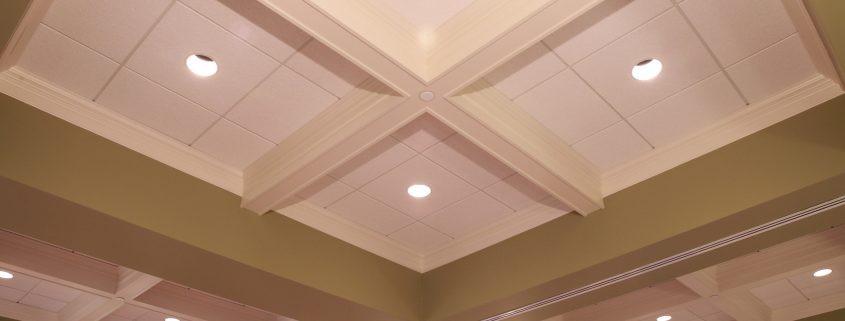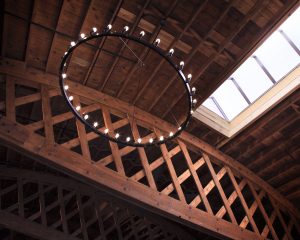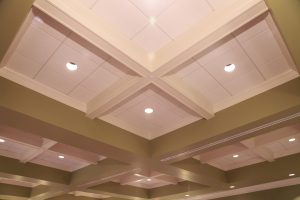Ceilings – Inspiring Solutions

Private Artist Studio – beamed ceilings designed by Bleck & Bleck Architects. © Photos courtesy of ancienttreeunderground.com
Beautiful ceilings can take your breath away and make your heart soar. Medieval cathedrals and Renaissance opera houses inspire us to look up and be amazed at the craftsmanship and intricate designs.
Today, there are an unparalleled variety of ceilings available to complement every space. When you make the right choice of ceiling system, you will help to create a safe, healthy and beautiful environment for work and leisure pursuits.
Function
The first consideration in choosing a ceiling system is its function. In many cases, the ceiling choices are limited by the function of the space. Specific acoustical properties, reflectance, and cleanliness will be required by building codes. Office spaces and residences may be the least restrictive in terms of codes and will allow the greatest variety of choices. Industrial environments typically require specialty ceilings. Restaurants need washable ceilings while gymnasiums need impact-resistant ceilings. Depending on the project you are undertaking, the choice of ceiling will be limited by the function of the space.
The right ceiling choice for your project may be very simple or elaborate, depending on the look you are trying to achieve. Sometimes the simplest-looking surfaces, like a smooth plaster ceiling, may actually be the hardest (think costly) to achieve. You can choose from trussed ceilings, beamed ceilings, coffered ceilings, smooth ceilings, textured ceilings, ornamental ceilings, and more. A stunning appearance can be achieved by experienced craftsmen who are familiar with the materials. Patricia’s dad was a specialist in ornamental plaster and was called on to repair and replicate plaster cornices at Lyric Opera and the Palmer House, among other well-known structures.
Materials
Many of us swoon at gorgeous, quality materials. Who doesn’t like the rich, natural look of wood or the cool striations in marble. There are as many choices in ceiling materials as there are for flooring and walls. For your project, you may be leaning toward drywall, plaster, acoustical lay-in panels, fabric, metal, or wood for your new ceiling. Also, consider applied finishes, such as wall paper and paint patterns, to achieve the look of natural materials at a fraction of the cost. Your final material choice may depend on your budget; material and labor availability in your area; or the look you are trying to achieve.
Acoustics
Loud or harsh spaces can be really uncomfortable. If you have a space like this, look up! Ceilings make a huge impact on acoustics; in fact, the ceiling is the most important room surface when it comes to acoustical performance.
As an example, we were called in to take a look at the acoustics for an existing office building lobby. Our client wanted to use the lobby for reception purposes, but it was just too loud. The beautiful modern space was cube-shaped, with hard surfaces and a high coffered ceiling. If you know anything about acoustics, you probably know that a cube is the worst possible shape for sound attenuation. We recommended adding fabric-wrapped acoustical panels to the ceiling in between the coffered areas. This simple, inexpensive change made a huge improvement in the acoustical comfort for the reception staff and guests.
To improve acoustical properties of a space, look first at the ceilings, followed by floors and then the walls. Furnishings also can absorb sound, but the most bang-for-your-buck (by far!) will come from addressing the ceilings. Here are some acoustical ceiling brands we like: GuilfordofMaine.com, CertainTeed.com, ArmstrongCeilings.com, and USG.com.
Reflectivity
Do you like your spaces to be light and bright? Consider the ceilings! Light reflectivity from ceilings, walls, and floors will change the entire mood of your space. Be aware that glare can become an issue if a space is too bright, especially when light reflects off computer and phone screens. In contrast, restaurant environments require darkening ability achieved through dimming and automated controls. In a well-designed room, the surfaces work with the natural and artificial lighting to create a pleasant, appropriate level of illumination during the day and night.
Versatility
Some ceilings are meant to help define a space or just look good. Others need to work a little harder. Mechanical and lighting systems are sometimes integral to ceiling systems. In addition, some ceilings need to allow easy access to building systems including mechanical, electrical or plumbing systems. In these cases, an acoustical lay-in ceiling may be the best choice for you. You may be familiar with basement spaces in the Midwest which are often fitted with lay-in ceilings for this very reason. Access panels can also be built into other ceiling types.
There are a wide variety of ceiling choices available today to complement every space. Take a look at some trends on Pinterest and Houzz or some truly inspiring older examples from around the world in AtlasofWonders. Ceilings are an important component of the overall building systems. They work with the other building systems to create a safe, healthy and beautiful working and leisure environment for all.





